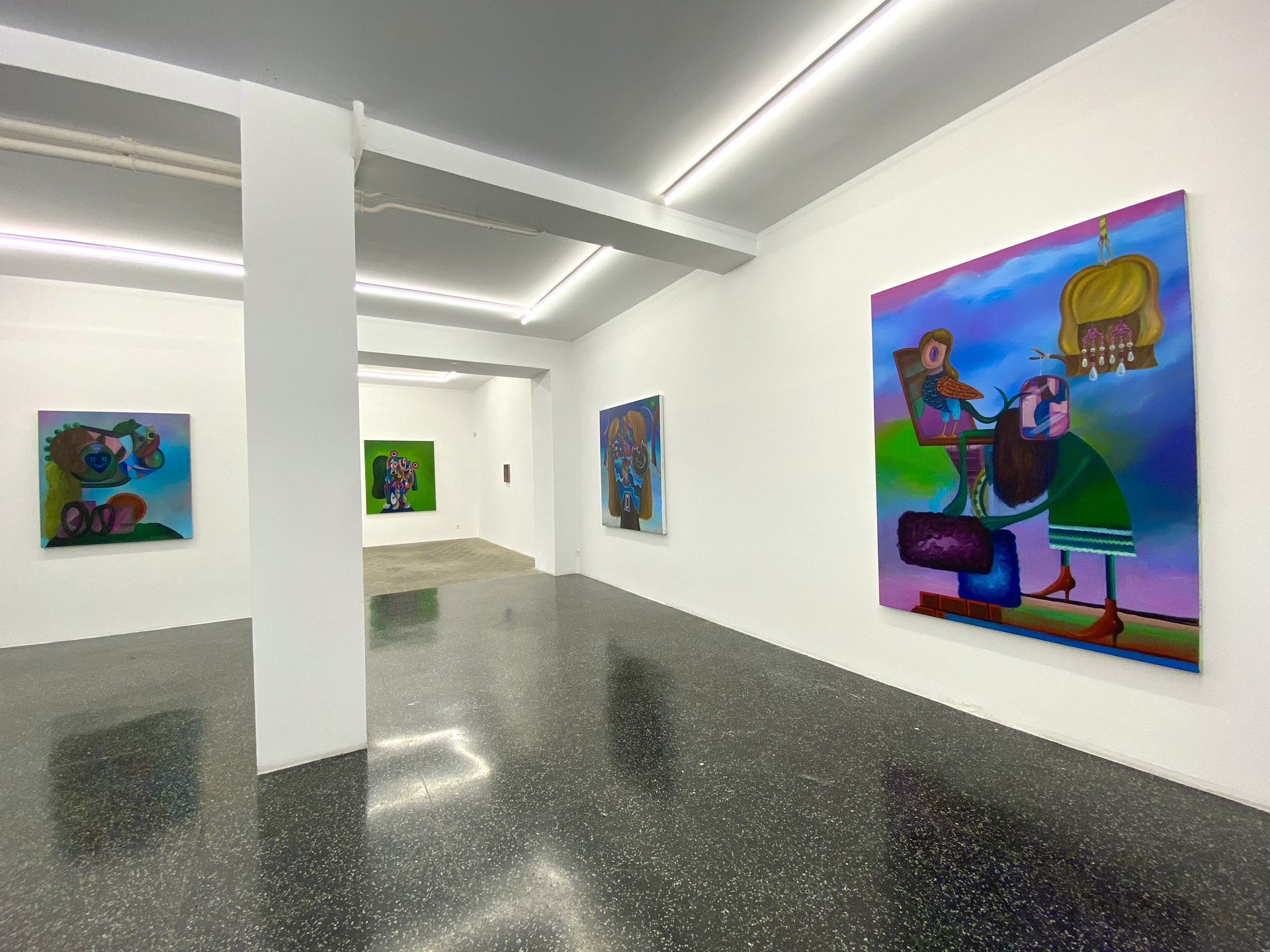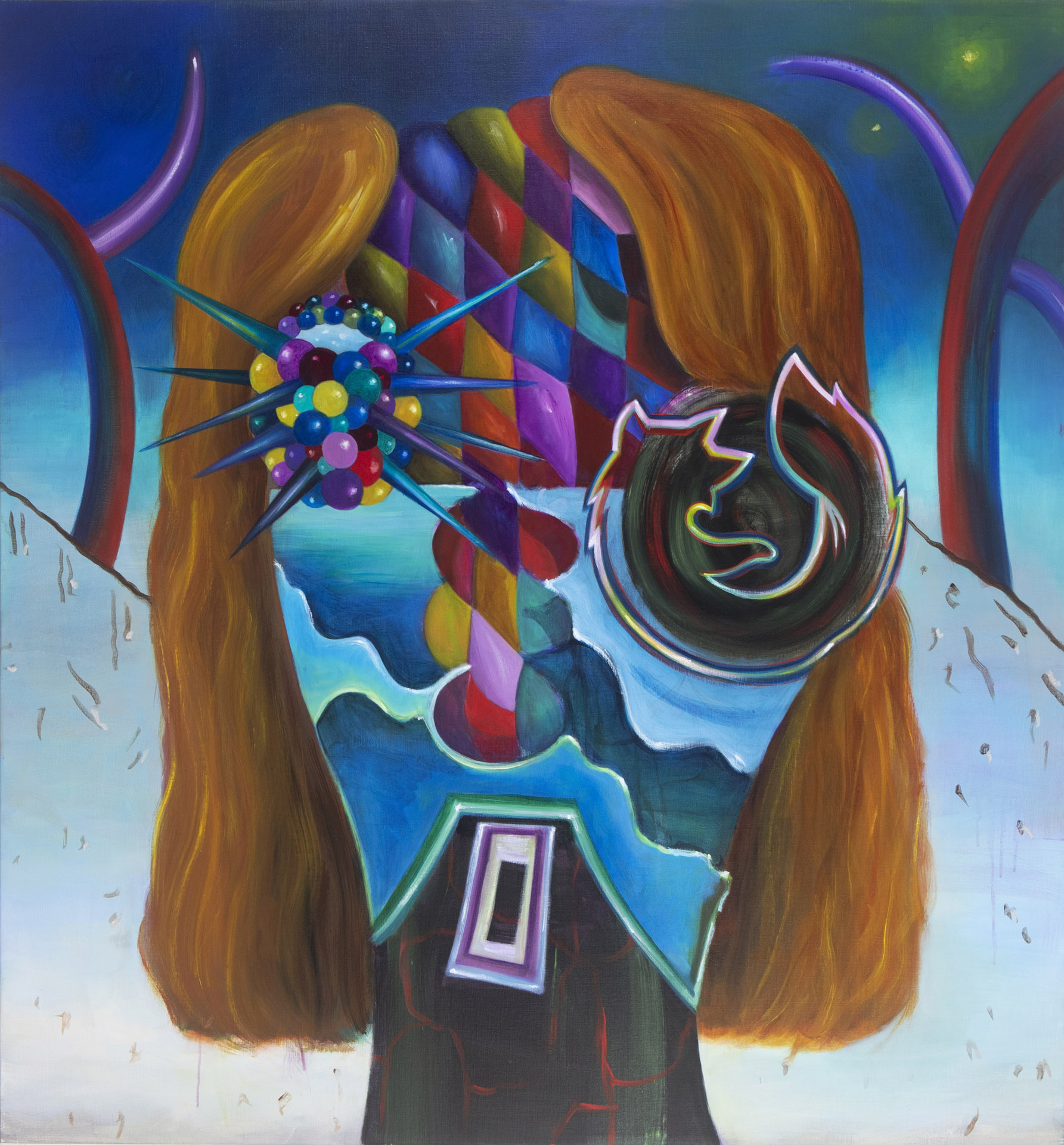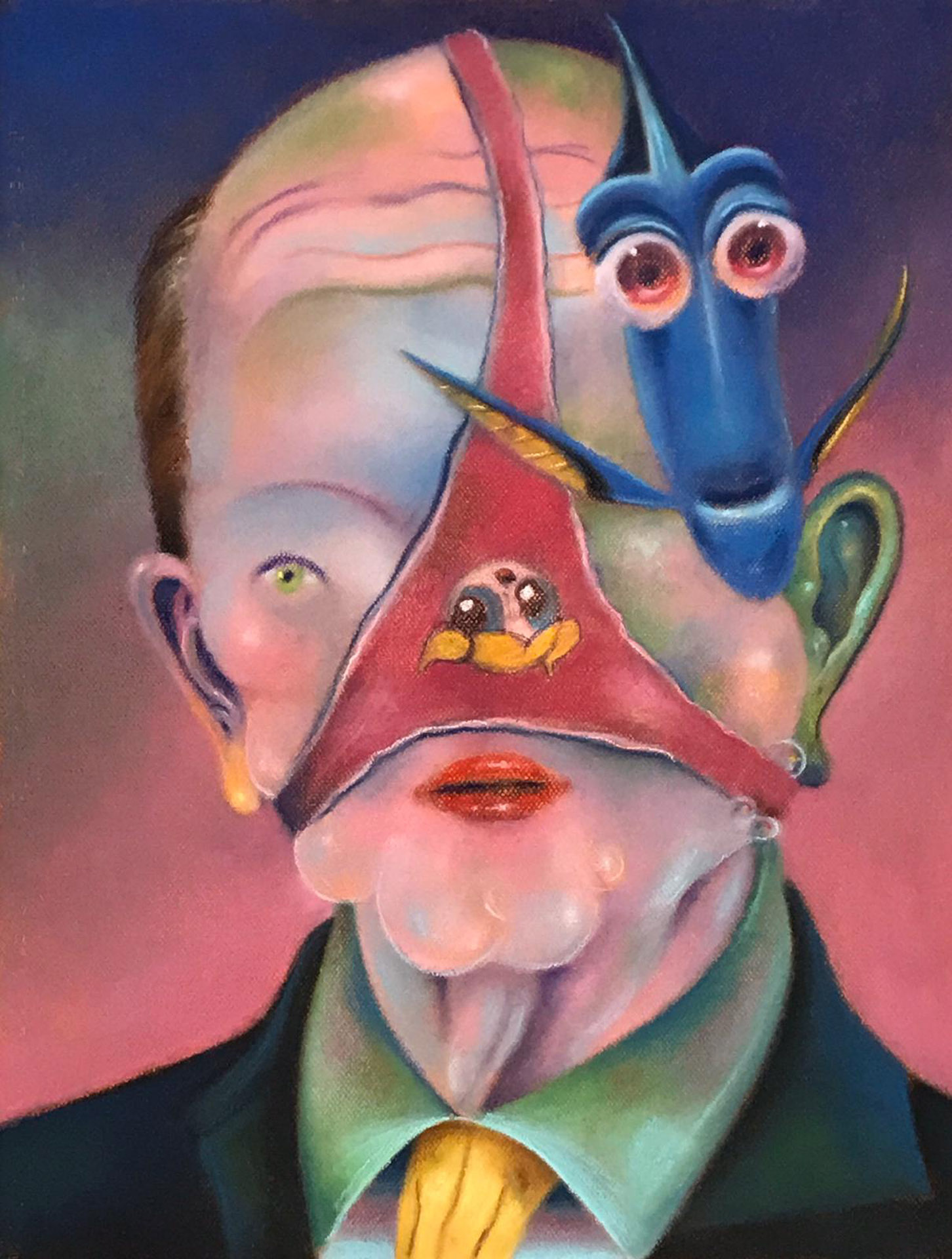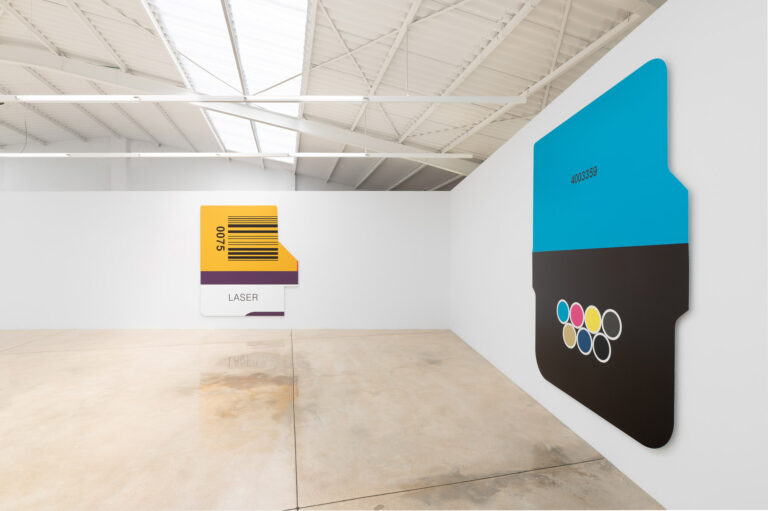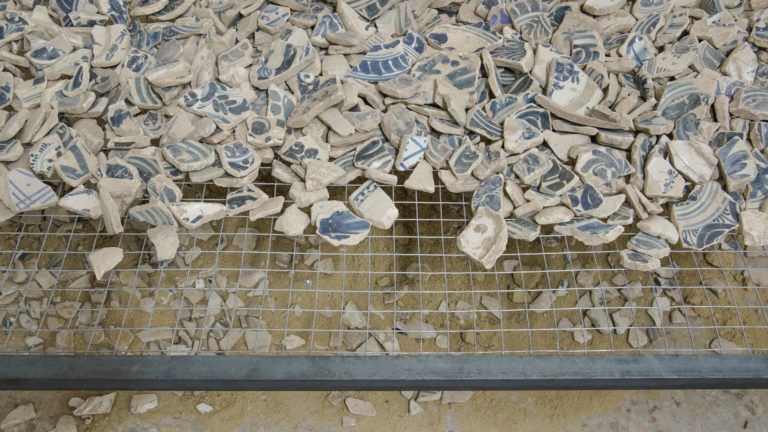Artist: Gorka Mohamed
Exhibition title: Hall of Mirrors
Venue: Marta Cervera, Madrid, Spain
Date: November 20, 2021 – January 29, 2022
Photography: all images copyright and courtesy of the artist and Marta Cervera, Madrid
Galería Marta Cervera has the honor to announce ‘Hall of Mirrors’, the first solo exhibition by Gorka Mohamed at the gallery. The show will be on view from November 20, 2021, until January 29, 2022.
In Hall of Mirrors Gorka Mohamed presents a series of portraits depicting abstract characters that are composed of recognisable and familiar features and objects, but, at the same time, give off a disquieting halo that instills a certain uneasiness. We could speak here of what Mark Fisher describes in The Weird and the Eerie, of why we find something unpleasant, even if it is framed within a certain familiarity, because it does not conform to our nature. However, although the characters may at first convey to us the virulence we might find on the margins of the society we currently inhabit, for Mohamed, these characters also show us how to appropriate what is toxic to us–in a social context–and how to transform it into a catalyst for its own remedy.
The title the exhibition takes its name from, Hall of Mirrors, refers to the famous ‘Hall of Mirrors’ in which Louis XIV used to host celebrations, receive mandarins and so on, with the aim of exhibiting his power through the building’s architecture; a hall of mirrors in which he could multiply his image and ego to infinity. Today, this reference brings us clearly to the multitude of screens that surround us, that when switched off turn into black mirrors, and which a large part of our current social interaction hides behind.
On the other hand, the aesthetics of Baroque portraiture are clearly visible in Mohamed’s paintings, something that can also be seen in the titles of his works and, which in specific periods such as the present where the sensory and the visual prevail, manifest themselves as a totally contemporary gesture. These Baroque nods also appear in some of the works’ titles such as The Marquis of Promiscuous Gear Stick. Mohamed acts as a ventriloquist through the pictorial language with which he makes his characters speak. Through the exercising of assemblage, disused objects and exaggerated physical features combine to construct psychological portraits of individuals and their psyches. This expressivity is taken to the limit, revealing Mohamed’s interest in the perverse morphology that exists in animated drawings, such as those created by Tex Avery, and other cartoons from the 20s and 30s. The characters are anonymous subjects who, although inspired by unknown people we may cross paths with on the streets of some city, represent archetypes and, therefore, traits that we recognise.
In the portraits, the eyes often take a leading role, as we can see in Pre-Islamic Jinn Swinging Tinnitus Rhapsodies for example. This places an emphasis on the sense of primacy that the visual has in today’s society; one in which we are constantly looking at screens. This is also our hall of mirrors behind which hides the perversity of algorithms. Brands and companies seek to translate and monetize data in order to create a standardisation of humanity. We could go so far as to say that today we ‘are’ so long as we ‘produce data’. In The Siliconization of the World Eric Sadin speaks of technolibertarism, referring to the social and political implications of conceiving the world as an automated organization of algorithmic systems and warns us of the dangers of moving towards the integral commodification of life. These references to the relation of the dependence on/control of the digital world are found in various works exhibited here and are evident in The Firefox Wizard of Oz or in Queen of Burn-Out Techies del Instagram of Hearts.
The technique used in these paintings also has reasoning behind it. In addition to using oil and acrylic on canvas, Mohamed incorporates pastels, as we can see in the work Puppet and Master Manipulator Reversing into One Another. The use of this medium appeals to him on the one hand, because of the gestural similarity to the techniques used in applying make-up, which in itself is the production of our own other mask, and on the other hand, because of the soft, blended textures, which remind him aesthetically and formally of current imagery. Mohamed is interested in reclaiming painting as a subtle gesture of attack on current economies, insofar as the pictorial works position themselves against today’s philosophy of production and the immediate consumption of images.
This series of portraits are not for quick consumption, one must spend a certain amount of time with each one of them, discovering details, signs, and probably, after a while, we will be surprised to find a smile of complicity on our faces. Although humour, at a glance, may not be intuited, it is very present in his works. The characters intrinsically carry stories with them, from which emanate a peculiar character. This is often manifested through the juxtaposition of opposites such as, for example, the unusual and the banal.
Mohamed’s portraits, shaped as abstract assemblages, are shown as the anti-selfie in that they move away from rehearsed poses and filtered images. Mohamed moves away from photogenics and positions himself in those often unsightly revealing angles. In this sense, he often looks at political figures, as in the case of Temporary Secretary, which alludes to Sarah Sanders, Donald Trump’s press secretary, and more specifically refers to the image of Sander’s face, almost deformed by its expression, transforming into the symbol of a lie. This question of how to represent someone from the most realistic angle possible leads us to Bakhtin’s ideas who claims that we never see ourselves as a whole, but that the other is necessary to achieve, however provisionally, the perception of the self. In fact, he goes on to specify that not even a mirror or a self-portrait can offer a complete view of the self. Identity does not belong to the individual alone but is shared by all.
An exhibition of portraits is of particular interest nowadays, in a social moment in which faces have acquired even greater prominence. On the one hand–all over the world due to the pandemic–a generalized use of masks has been imposed, preventing us from seeing a large part of the faces of the people we come across in our daily lives. In fact, it is often the case that sometimes we only see full faces through a digital photograph or a video call. On the other hand, the prominence of faces is marked by facial-recognition technology, which uses the face as a sign of authenticity; our face is the proof of our identity. This attempt to objectify faces, begs us to counter it with the ideas of Levinas, who in his essay ‘The Face of the Other’ deals with the question of otherness through the face, and affirms that the face is after all neither a physical nor an aesthetic object, it is constituted as a living presence, which we receive as pure expression, it challenges us, and therefore, it will always be impossible to capture the infinity of ‘the other’.
-Gema Melgar
Gorka Mohamed (Santander, 1978) lives and works between London and Santander. He graduated in 2003 from Escuela Massana, Barcelona, and received his MFA in 2008 from Goldsmiths University of London. His work has been featured at Patio Herreriano Museum (Valladolid), Matadero Madrid, Centro Centro / Palacio de Cibeles (Madrid), Centro de Exposiciones Caja Granada, Santander Museum of Modern and Contemporary Art, Seoul Museum of Contemporary Art, Hammana Artist House (Lebanon), One Art Space Gallery (New York), Timothy Taylor Gallery (London), among others. Latest solo shows include: I Would Prefer Not To, Galerie Thomas Bernard (Paris, 2019), The Mad Dog of The Desert, Dar El-Nimer (Beirut, 2019), I ARE, Galerie La Mauvaise Réputation (Bordeaux, 2018), Raise Ravens and They’ll Pluck Out Your Eyes, Peter Von Kant (London, 2016), Ha, Ha, Choi&Lager (Cologne, 2016). Mohamed’s work is part of public and private collections such as Brillembourg Capriles, Solo Collecition, Pilar Citoler Collection, Olor Visual, Patio Herreriano, among others. He has been included in publications of international prestige such as 100 Painters of Tomorrow by Thames & Hudson and Young London 2011-2014 by Grey Tiger Books.
Gorka Mohamed, Hall of Mirrors, 2021, exhibition view, Marta Cervera, Madrid
Gorka Mohamed, Hall of Mirrors, 2021, exhibition view, Marta Cervera, Madrid
Gorka Mohamed, Hall of Mirrors, 2021, exhibition view, Marta Cervera, Madrid
Gorka Mohamed, Hall of Mirrors, 2021, exhibition view, Marta Cervera, Madrid
Gorka Mohamed, Hall of Mirrors, 2021, exhibition view, Marta Cervera, Madrid
Gorka Mohamed, Hall of Mirrors, 2021, exhibition view, Marta Cervera, Madrid
Gorka Mohamed, Hall of Mirrors, 2021, exhibition view, Marta Cervera, Madrid
Gorka Mohamed, Hall of Mirrors, 2021, exhibition view, Marta Cervera, Madrid
Gorka Mohamed, Hall of Mirrors, 2021, exhibition view, Marta Cervera, Madrid
Gorka Mohamed, Hall of Mirrors, 2021, exhibition view, Marta Cervera, Madrid
Gorka Mohamed, Hall of Mirrors, 2021, exhibition view, Marta Cervera, Madrid
Gorka Mohamed, The Firefox Wizard of Oz, 2021, Acrylic on linen, 150 x 140 cm
Gorka Mohamed, Queen of Burn-Out Techies del Instagram of Hearts, 2021, Oil on linen, 125 x 110 cm
Gorka Mohamed, Trapdoor, 2021, Oil on linen, 200 x 144.5 cm
Gorka Mohamed, Puppet and Master Manipulator Reversing into One Another, 2021, Pastel on canvas, 130 x 100 cm, 136 x 106 cm (framed)
Gorka Mohamed, Relocated Memories From London 276 Bus Journeys, 2021, Oil on raw linen, 59.5 x 44.5 cm
Gorka Mohamed, Katharine Rooibos del Soft-totalitarism, 2019, Acrylic on Linen, 35.5 x 25.5 cm
Gorka Mohamed, Amnesiac, 2020, Pastel on paper, 65 x 50 cm, 72 x 57 cm (framed)
Gorka Mohamed, Libertine, 2020, Pastel on paper, 65 x 50 cm, 72 x 57 cm (framed)
Gorka Mohamed, Untitled, 2020, Pastel on paper, 65 x 50 cm, 72 x 57 cm (framed)
Gorka Mohamed, Temporary Secretary, 2020, Pastel on paper, 65 x 50 cm, 72 x 57 (framed)
Gorka Mohamed, The Marquis Of Promiscous Gear Stick, 2021, Pastel on paper, 65 x 50 cm, 72 x 57 cm (framed)









